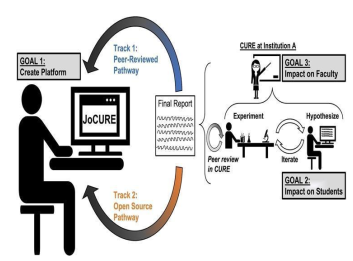Investigation of Subunit Interactions of Glyoxysomal Malate Dehydrogenase Using Engineered Cysteine Residues
Author(s): MJ Drake1, ellis bell2
1. University of Richmond 2. University of San Diego
1208 total view(s), 62 download(s)
Description
Despite the fact that Malate Dehydrogenase was one of the first multisubunit enzymes to have its structure determined by x-ray crystallography, many questions remain about the mechanism and role of subunit interactions in this protein. To provide a quantitative framework to analyze engineered interface mutants, a single cysteine residue has been engineered into the subunit on the outer edge, furthest from the interface and shown to be reactive five native cysteine residues all appear buried and inactive in the native form of the enzyme. Random labeling of the 2 cysteines per dimer with Alexa Fluor 488/AF647 approximately 52A or AF 546/647 approximately 63A is being used to allow resonance energy transfer measurements between the two halves of the dimer to probe ligand induced changes over long distances and effects on dimer stability. In an alternative approach, preliminary data has been obtained focused on using the engineered sulfhydryl groups to immobilize the dimer on the gold tip and stage of an atomic force microscope to allow pulling type experiments to probe the effects of ligands on the stability of the dimer interface relative to the protein structure using analysis of the resultant force curves.
This work is supported by NSF Grant MCB 0448905 to EB00
Cite this work
Researchers should cite this work as follows:
- Drake, M., bell, e. (2023). Investigation of Subunit Interactions of Glyoxysomal Malate Dehydrogenase Using Engineered Cysteine Residues. Journal of CURE Research, QUBES Educational Resources. doi:10.25334/N20K-RY51
